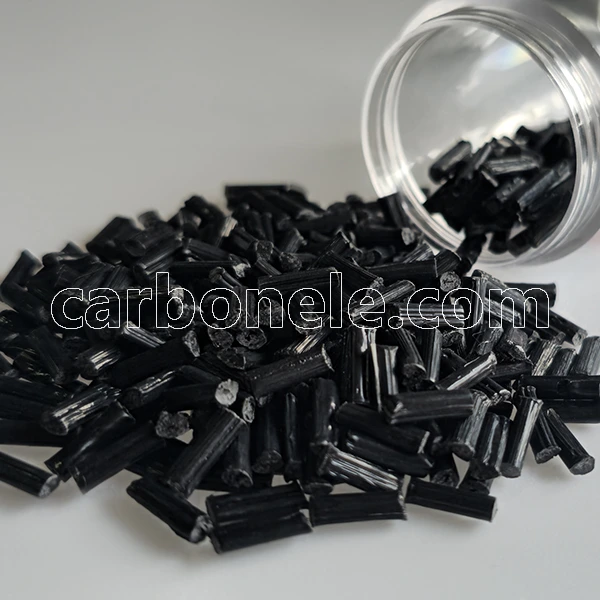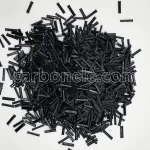
Chemical Resistance PP LCF50 Factory Prices
PP LCF50 features high strength and rigidity due to a high proportion of long carbon fibers. It’s lightweight compared to metals. Has excellent heat and chemical resistance. Good processability allows for complex part manufacturing.
- Model No.: PP-LCF-BCA5
- Matrix Resin: Polypropylene
- Filler: Long carbon fiber
- Free Sample: 3-25kgs
- OEM/ODM: Acceptable
- N.W.: 25kgs
- Origin: Xiamen, China
Composition
PP LCF50 is a thermoplastic composite material based on polypropylene (PP), with 50% long carbon fibers as the reinforcing filler. This design significantly enhances the material’s strength and rigidity while maintaining excellent processability.
Composite Method
PP LCF50 uses an impregnation method for its composite production. Specifically, long carbon fibers are immersed in molten polypropylene to ensure uniform distribution and thorough impregnation. This method strengthens the bonding between the carbon fibers and polypropylene, thereby improving the overall performance of the composite material.
Performance Characteristics of PP LCF50
1. High Strength: The high proportion of long carbon fibers enhances the material’s tensile and flexural strength, making it perform excellently under high loads.
2. High Rigidity: The rigidity of PP LCF50 is significantly increased, making it suitable for applications requiring high structural stability.
3. Lightweight: Compared to traditional metal materials, PP LCF50% has a lower density, thereby reducing the weight of components.
4. Excellent Heat Resistance: The material maintains stable performance in high-temperature environments, making it suitable for high-heat applications.
5. Outstanding Chemical Resistance: It exhibits good resistance to most chemical substances, extending its service life.
6. Good Processability: As a thermoplastic material, PP-LCF50 can be processed through injection molding and other methods, facilitating the manufacture of complex-shaped parts.
Application Areas
PP LCF50 finds widespread use in automotive, aerospace, electronic devices, and industrial machinery fields, particularly in applications requiring high strength, low weight, and heat resistance.
Application Case: Automotive Engine Components
In the automotive industry,LCF50% PP is utilized in the manufacture of high-performance engine components. For instance, consider the engine cover of a high-performance sports car. Traditional materials tend to deform in high-temperature environments, whereas the excellent heat resistance and high strength of LCF50-PP make it an ideal choice.
Application Scenario of PP LCF50
PP LCF50 composite material from Carbon (Xiamen) New Material was chosen for the engine cover of this sports car. The engine cover needs to withstand the high temperatures generated by the engine while maintaining a low weight to enhance vehicle acceleration. With PP LCF50, the strength of the component was improved by approximately 30%, and its weight was reduced by 15%. These improvements significantly enhanced the vehicle’s overall performance and fuel efficiency.
Furthermore, the chemical resistance of PP LCF50% ensures that the engine cover performs well against oils and other chemicals, greatly extending the component’s service life. This not only reduces maintenance frequency but also enhances the owner’s experience.
Through this application case, LCF50% PP demonstrates its exceptional performance in high-demand environments, showcasing the innovation and technological leadership of Carbon (Xiamen) New Material.
Distinct carbon fiber reinforced and modified thermoplastic composite starting materials show discrepancies in performance because of elements like various matrix resins, the quantity and kind of carbon fibers, and production techniques. The merits of particular composites still need to be precisely assessed by conducting comparison and testing with specific other carbon fiber reinforced plastics as per actual application demands. Moreover, thermoplastic composites manufactured by different producers may have different focal points and variances in performance. If more accurate and detailed information is needed, it is advisable to consult the product brochures and technical data sheets of relevant manufacturers or get in touch with us directly.
If you want to obtain more information about carbon fiber reinforced and modified thermoplastic composites by watching videos, please click here. Thank you.
How to Buy?
If you have an interest in buying PP LCF50 composite material, contact Carbon (Xiamen) New Materials, the producer directly. Acquire information like product specs, capabilities, and prices, and pick the suitable product as per your own demands. Meanwhile, you can request the manufacturer to supply samples for testing to make sure the material complies with your usage needs.

Frequently Asked Questions
Carbon (Xiamen) New Material Co., Ltd. aims to provide buyers with "one-stop" worry-free high-quality services. Here you can find all information about carbon fiber engineering plastics. If you still have questions, please send us an email for consultation!
-
How can I contact the manufacturer of a product that interests me?
When you find a product you are interested in, you can contact the manufacturer directly by sending an email and we will get back to you as soon as possible.
-
How do I find the products that interest me?
All you need to do is enter the keyword, product name in the search window and press the Enter key on your keyboard. Your search results page will then be displayed. You can also search within the product category pages on the home page. Each category is divided into subcategories, allowing you to refine your search and find products that interest you.
-
Where will I find a buying guide?
Please contact our after-sales service directly and we will provide you with a comprehensive operating guide.
-
What are CF Reinforced Thermoplastic Composites?
CF Reinforced Thermoplastic Composites are materials where carbon fibers are incorporated into a thermoplastic matrix. They combine the strength and stiffness of carbon fibers with the processability and recyclability of thermoplastics. For instance, they are used in automotive parts like bumper beams.
-
What are the benefits of CF Reinforced Thermoplastic Composites over traditional composites?
The key benefits include faster production cycles, easier recyclability, and better impact resistance. They also offer design flexibility. An example is in the manufacturing of consumer electronics casings where complex shapes can be achieved more easily.
-
How are CF Reinforced Thermoplastic Composites processed?
Common processing methods include injection molding, extrusion, and compression molding. Injection molding is widely used for mass production. For example, in the production of small components for the medical industry.
-
What industries use CF Reinforced Thermoplastic Composites?
They are utilized in aerospace, automotive, medical, and sports equipment industries. In aerospace, they can be found in interior components. In the medical field, they might be used in prosthetics.
-
How does the carbon fiber content affect the properties of the composites?
Higher carbon fiber content generally leads to increased strength and stiffness but may reduce ductility. A moderate content is often balanced for specific applications. For example, a higher content might be preferred in structural parts of a race car.
-
What are the challenges in using CF Reinforced Thermoplastic Composites?
Challenges include higher material costs, complex processing equipment requirements, and ensuring uniform fiber dispersion. Issues with adhesion between the fibers and the matrix can also arise. An example is in achieving consistent quality in large-scale production.

























